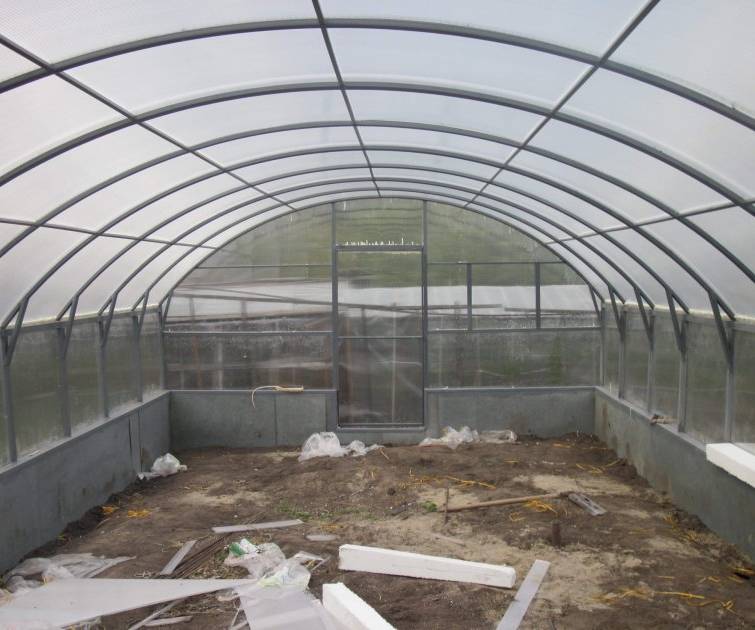Many summer residents tend to make a greenhouse on their site. This is a good way to grow plants and get vegetables and berries. Thanks to greenhouses, you can harvest from early spring to late autumn. In addition, such structures can be electrified by laying a cable there, and provide heating and lighting there. In this case, you can create optimal conditions for growing vegetables even in the coldest season.
However, before you make a greenhouse with your own hands, you first need to carefully consider the future structure. Construction must be carried out according to a pre-developed project, ready-made schemes and drawings. There are several types of greenhouses, which differ in the types of materials and structures used. We will figure out what types of greenhouses for a summer residence you can choose, how to build it, what to make a frame from, what sizes to choose for a structure.
What material to choose for the base?
The peculiarity of greenhouses is that the greenhouse can be assembled from almost any material. With certain skills and tools, almost everything that is on your site is suitable for arranging. To begin, consider the basic materials for the frame of the greenhouse.- Tree. Eco-friendly and easy-to-work material. Putting together a wooden frame for a greenhouse is not difficult. In addition, such a greenhouse will not be expensive. However, wood is a fragile material that can easily break in the event of a strong storm. In addition, wood is unstable to temperature extremes and high humidity. To prevent this from being a problem, the microclimate in the greenhouse must be constant, and the material must be treated against decay.
- Metal. Often, old pipes, fittings, channels, etc. are used to create greenhouses. This material is highly durable. Such greenhouses are practically not afraid of anything. Finding pipes is easy. However, the metal frame is prone to corrosion. Therefore, rust can crumble on the soil and on the leaves of plants. In addition, working with a metal frame requires certain skills. For example, welding.
- Plastic. Plastic pipes are also well suited for creating greenhouses. Often even ready-made plastic kits are sold, which can be assembled very easily and quickly using the instructions. It is very easy to work with plastic, it has a minimum weight, it is easy to cut, it is resistant to changes in the internal microclimate. However, plastic has the same drawback as wood - it is brittle. Therefore, problems can arise with the greenhouse in case of strong winds.
How to choose a place and what foundation to prepare
One of the most common questions is where to place a greenhouse. The recommendations here are quite simple. Before choosing a place for a greenhouse, you need to make sure that there are no trees and shrubs nearby. Firstly, it is important not to damage the walls and roof, and secondly, so that they do not create shadows.
The main criterion for choosing a place is the direction of the world. The place should be as lit as possible so that there is as much light as possible. With the right choice of point for installation, you can put a greenhouse even near the house. The main thing is that it does not create shadows.
Another important question is what kind of foundation is needed for the greenhouse. It is better to install it, because otherwise the greenhouse will not be strong enough. There are several options here:
- Strip foundation. Classic foundation. To do this, you need to fill with rubble and pour cement mortar. Reliable, strong and durable foundation. However, there are certain problems associated with the materials. They need a little, and you can not buy a small amount of crushed stone, sand or cement everywhere.
- Brick. This type of material is also distinguished by good strength and durability. Construction technology will take some time. First you need to dig a trench and make a cushion of rubble. Next, you need to perform brickwork and make anchors on which the frame of the greenhouse will be attached. The disadvantage here is the same as that of the strip foundation.
- Bar. Another common option. It is convenient that all materials can be bought by the piece. To build the foundation, you need to dig a trench around the perimeter, lay insulation in the form of roofing material. Further, a beam is laid along the perimeter. The frame is bolted on. The main disadvantage of timber is that it is not as durable as a strip foundation or brick.
- Pile foundation. It is convenient in that the materials for its creation can be found on your site. To do this, you need 6-8 columns of metal or concrete. Then the base is connected with each other by metal pipes. A pile foundation is fast, simple, but not for a heavy load.
 Found a mistake on the site? Tell us:
Found a mistake on the site? Tell us:

 Telegram
Telegram
